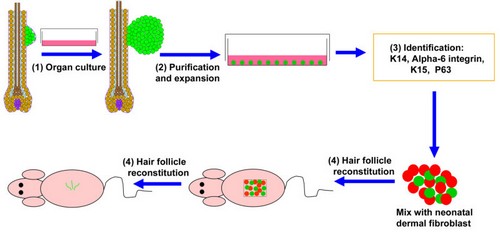Hair follicle stem cells (HFSCs) are potentially useful for the treatment of skin injuries and diseases. To achieve clinical application, a prerequisite must be accomplished: harvesting enough HFSCs from limited skin biopsy. The commonly-used sorting approach for isolating HFSCs, however, suffers from its intrinsic disadvantages such as requirement of large-scale skin biopsy. Here, we report an efficient organ culture method to isolate and expand rat HFSCs from limited skin biopsy and these HFSCs could reconstitute the epidermis and the hair follicles (HFs). 73% of cultured HFs formed hair follicle stem cell colonies from the bulge, and a single hair follicle provided all the HFSCs used in this research, demonstrating the high efficiency of this method. Quantitative RT-PCR and immunofluorescent staining results revealed that these stem cells obtained from the bulge highly expressed basal layer markers K14 and alpha-6 integrin, epithelial stem cell marker P63 and bulge stem cell marker K15. After long-term culture in vitro, GFP-labeled hair follicle stem cells formed new hair follicles, epidermis, and sebaceous glands following xeno-transplantation into the back of nude mice. This study indicated that multipotent hair follicle stem cells could be efficiently harvested through organ culture from limited skin material—even a single hair follicle—and reconstitute hair follicles in vivo after long-term expansion culture, providing the basis for future clinical applications.
Shoubing Zhang, Huimin Hu, Huishan Zhang, Shuang Liu, Shu Liu, Ying Zhang, Xiaohua Lei, Lina Ning, Yujing Cao, and Enkui Duan. Hair follicle stem cells derived from single rat vibrissa via organ culture reconstitute hair follicles in vivo. Cell Transplantation. 2012 Apr 24. [Epub ahead of print]
Article linkage:http://masetto.ingentaselect.co.uk/fstemp/a0817edbf6bbb86199d60449e1cf6b42.pdf


